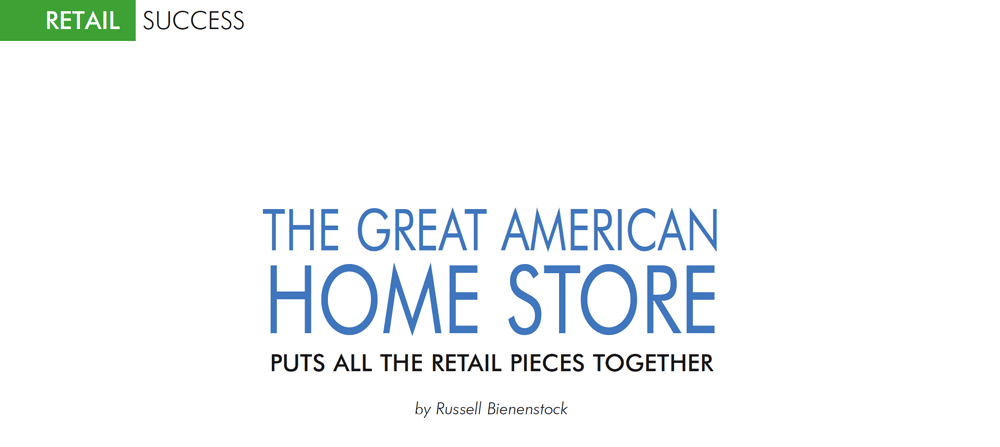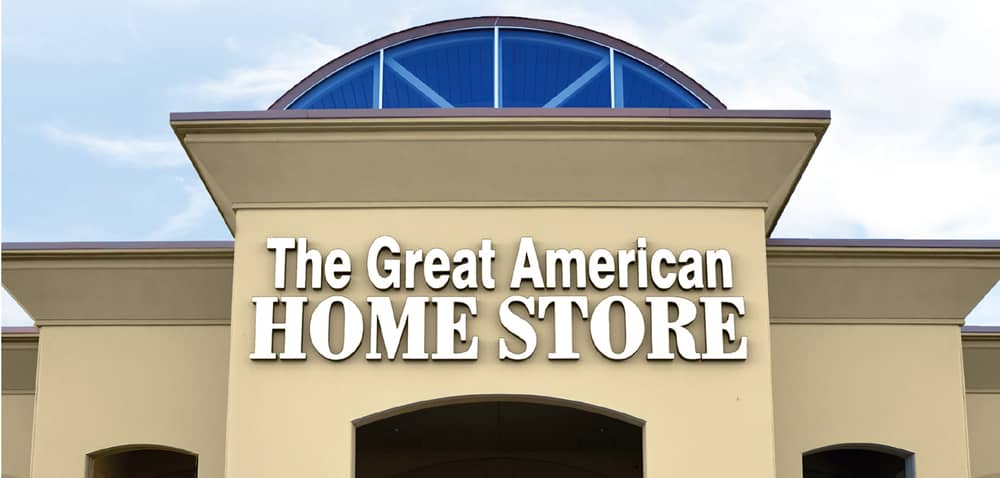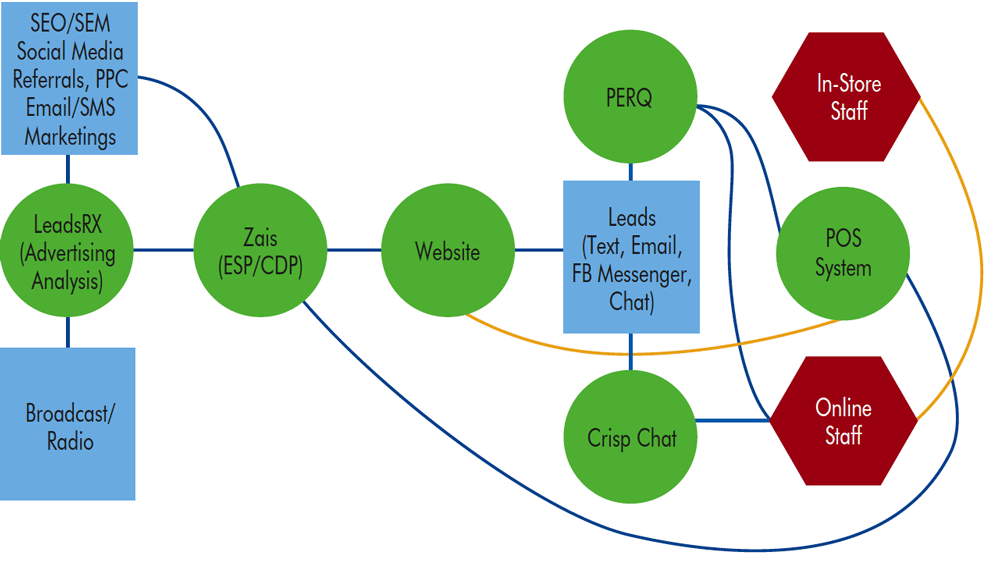
After a rocky start with
its online sales platform, GAHS achieved growth in eCommerce sales of 1200 percent during the pandemic.
The last time Furniture World spoke to Ron Becker, one of the founders and general manager of The Great American Home Store, it was 2014. At that time GAHS operated two full-line stores—their original location in Southaven, Mississippi, a second location in Memphis, plus a free-standing sleep shop. At the time, Becker was in the midst of planning his first foray into eCommerce. He says the rollout didn’t go smoothly.
“We would maybe take a step forward and then fall back a step. There were challenges, mostly having to do with systems integration.”
Jack Wells Jr., Great American Home Store’s marketing director, who was in charge of implementing eCommerce told Furniture World, “At the time our website was excellent, but it was mostly set up for presentation. It wasn’t set up for selling online, for true interactive marketing, and for interacting with shoppers the way we do today."
eCommerce Initiative
“So, we assembled a team to build out a custom website that we could market from," Wells continued. "And, decided to keep the existing point-of-sale software we were comfortable with instead of going through the work of switching over to an integrated software package that would do live inventory and price updates. Eventually we got our systems to work well together.”
We went from roughly an 11 percent
conversion rate to between 25 to 29
percent from onlineleads, and this return continues to improve as we add more resources.
|
Justin Bowen, Great American Home Store’s digital manager, was hired in 2014 to handle website product content. When the person responsible for eComm implementation left suddenly, Bowen recalled, “I had to get up to speed pretty quickly. As Jack mentioned, after several years of spinning our wheels trying to get our website integrated with our point-of-sales system we realized that wasn’t going to work. So, we made the tough decision to switch site platforms. We spent most of last year working on that project to make the conversion.” That preparation was good timing for GAHS after COVID-19 hit.
A New Front Door
“PERQ provides our lead generation and other ways to engage customers." Bowen elaborated, “There’s a lot of information coming in through our website. We have two dedicated staff members who sort through leads and qualify them. Then, they coordinate with our in-store sales and support staff as needed. Ever since we made the change from having our in-store staff doing this work, the benefits have been huge. We went from roughly an 11 percent conversion rate to between 25 to 29 percent from online leads, and this return continues to improve as we add more resources."
The in-store staff uses a web-based application called Crisp, an online, omni-channel platform to communicate with customers. “If a shopper or existing customer sends us a message via text, email, Facebook messenger or chat,” said Bowen, “that information is transferred into Crisp. It’s a great fit for us for a number of reasons. Crisp is extremely well developed in terms of its feature set and has a single inbox so our entire staff is able to see every conversation. This helps with transparency. If somebody drops the ball, someone else can pick it up without an individual having to forward it from their personal inbox. Forwarding is what we used to do, and it did not work well.”

All Great American Home Store showrooms have a signature look. Ron Becker prefers to locate along interstates. The highly visible facades are impressive and "become a landmark when you’re given directions in the area," noted Jack Wells.
|
Justin added that fragmented communications resulting from information coming in from different channels can be hard for retailers to manage. “Crisp helped us unify those different online and in-store channels in one place to make sure that both leads and customers get taken care of in a cooperative process.“
The result is that GAHS has the ability to put information into Crisp to let salespeople know that there’s an available lead they can follow up on. “Everyone including managers, sales, support and service staff have been trained to work the system, Bowen concluded, “everybody knows how to use it.”
“Crisp is working out real well for us,” said Jack Wells. “All of our people are tied to it and we can review their conversations with customers. Customer service people can be brought in when needed as well.
Rapid Growth
“The front door to our physical stores is not the first entry point. It is now our website. My guess is that 99 percent or more of the customers who visit our physical store have been to the GAHS website first.”
Ron Becker agreed, “I would say it’s almost 100 percent. Once shoppers begin to have conversations with our staff through Crisp, and get comfortable with our question and answer sessions, they move to the next step and come on into the store. That process takes anywhere from 24 hours to 10 days.
There’s a lot of
information coming in through our website from PERQ.We have two
dedicated staff members who sort through leads and qualify them.
|
“Shoppers have a choice of how to communicate on the Great American Home Store website. It can be via text, email, or a phone call. Once a conversation gets started, we check off a box, so to speak. Then it’s our job to make potential customers feel comfortable enough to visit the store.”
“Salespeople have plenty of time when they are not up on the floor, said Wells. “They can be much more productive if they go into one of our kiosks, get online and talk to customers. That’s how we are growing our business.”
Sales in the Age of COVID
“After being shut down during the pandemic, it took us about 10 days to get our act together, get our feet underneath us and put a plan together,” noted Becker. After the first 10 days we started selling online again.
“We identified 20 salespeople who had the credentials, qualifications and abilities to work from home and sell online using tablets supplied by GAHS. ”
“We were up about eight percent before it hit," Wells added. ”Then all of the sudden everything went south. We stopped advertising and closed down for about six weeks. The company lost almost a million dollars over that six week period.
“But our eCommerce business went up 1,200 percent. That was on top of the previous 33 percent increase because we were already moving in that direction. As the store opened up to floor traffic we didn’t maintain that level, but year to date eCommerce sales are up almost 300 percent. That doesn’t include sales we can track back to conversations that started online.”

Information flow chart depicts how Great American Home Store handles and coordinates lead traffic.
|
More Challenges
Jack Wells, who has worked in a number of other industries told Furniture World that the furniture industry is probably the most backward industry as far as technology usage he’s ever seen. “Operations like Wayfair and Amazon have a good grip on how it should be done. We’ve watched these guys and learned, but furniture manufacturers are just now starting to work hard at it. They’ve been slow to grasp what’s going on. Stores like us need their support. We need furniture brands to develop and supply decent marketing and web tools we can use.
“Another big challenge for many furniture retailers is getting their people to engage with new technology—especially salespeople. In the beginning, some of our top salespeople who were getting on up in years didn’t grasp the technology.
“For example, we could hardly get one of our best salespeople to read his email before the pandemic hit. But when our stores shut down he figured out quickly that he could still sell furniture using the technology.”
“The gentleman Jack is talking about,” Becker chimed in, “needed a push in the right direction. I went into the break room one morning before the store opened up, and let him know, ‘While we’re shut down, you have to figure out a way to earn your keep. And, I strongly suggest that you use the Crisp program so you can sell some furniture while we’re shut down!' He sold over $100,000 that month.”
Advertising
After cutting out all advertising when the store was closed for six weeks during the pandemic, GAHS started with radio, plus standard 30-second and one-minute television commercials to help customers feel safe about coming back into GAHS stores or buying online and using touchless curbside options. The average ticket for an online sale at Great American Home Store during the first months of the pandemic was about one third of their normal average in-store sale. “At that time,” noted Becker, “customers were just buying the items they needed right away—items that they could pick up in their truck, horse trailer or flat bed.”
When asked if that changed once things started opening up, Jack Wells explained that the store was “up 13.26 percent over last year, at the end of August.”

Pictured above is Ron Becker (top), one of the founders and General Manager of The Great American Home Store. Jack Wells (bottom) is Marketing Director.
|
Lead Metrics
Advertising metrics generated by the LeadsRx application are an important element in Great American Home Store’s strategy.
Digital manager Justin Bowen observed that “The buying cycle has gotten so complex it’s become necessary to view it as touch points that push shoppers further in the funnel to get them to take the next steps. Over time we’ve added more digital advertising and marketing channels. What LeadsRx helps us do is put together a more complete picture of the effectiveness of our television, radio, website, social media, blog, Google ads, YouTube and other digital channels.
I am surprised how much business we are doing even though we are, at this time, struggling to get inventory back into our distribution centers.
|
“It creates a profile for web visitors and tracks advertising effectiveness using television and radio post logs of when people are coming to our website within a certain defined period after viewing an ad. Let’s say an ad runs at five p.m. on a Monday. LeadsRx can look at an eight-minute window after that ad aired and measure any spike in website traffic above a benchmark average. The program generates reports that allow us to compare our advertising buys, stations, time slots and creative so we can make better buying decisions.
“When we got into the COVID -19 situation LeadsRx helped us reduce our broadcast budget initially by 50 percent and then 100 percent. Ever since then, we’ve stayed at a reduced budget while making informed decisions about what spots to keep in order to generate the most traffic and conversions. On the web side we can see how well traffic is converting broken down to the UTM level and the referral level. Pretty much any way we want to slice it and dice it, we can.
“We’ve noticed that before COVID, it took a lot less time for people to buy. Right now, it’s taking almost twice as long. It takes more interactions, research and questions asked to get to a sale. We’ve also seen a big up-trend in people using the site—a 60 percent increase in the number of website visitors locally compared to last year. It’s a much more considered purchase now.
"We’ve also started working with a company called Zaius, for in-depth customer data and email marketing. They held our hand and helped us to get up and running with the platform very quickly. It’s helped us to implement a lot of automated campaigns we had never been able to do before."
GAHS Going Forward
"I’m shocked at how much business we’re still doing on a daily basis," said Ron Becker. “I am surprised by how much business we are doing even though we are, at this time, really struggling to get inventory back into our distribution centers.
“The industry is having difficulty getting their workforce to come back and to put their hands on raw goods to build product. God has looked over us,” said Ron.
“I’m an optimist by nature but I’m fearful that we still face a lot of challenges going forward, like 20 million people unemployed, a workforce that is afraid to go back to work, school systems that may or may not open, not to mention the extra $3 trillion in government debt, with more to come."
Location, Location
Furniture World asked Ron Becker if he has expansion plans beyond eCommerce. “I think that we will do both he replied. We’re actively looking at two markets, both within 250 miles of the Memphis area. We will always continue to look to expand into our brick and mortar capabilities. Our online sales, if we continue to give it the necessary attention and resources, will lead to a revenue stream equal to one brick and mortar."
“Right now,” Jack added, "is a good time to buy commercial real estate. Ron likes to build his buildings and keep them as investments for return later on.”
“Building a showroom and warehouse together on one side of an interstate should give me 25 years of growth potential, and a market,” Becker observed. When we build in inner cities, I’ve found we’re only good for five, six, or seven years. These areas change as people move to another hot location. Then, a retailer can be left sitting in a dead area. Interstates leading into or out of a community are good for a longer period of time. And that’s this old man’s philosophy.”
Another advantage Great American Home Store gets from locating along interstates is advertising exposure. Jack Wells points to the impressive and visible facade. “It’s our brand, a highly visible landmark along interstates that people refer to when they are giving directions to others. We are not just investing in a building. It’s a huge billboard that can last for 25 or 30 years."
Conclusion
In closing, Ron Becker shared his thoughts about founding GAHS. "When we started the Great American Home Store I was 52 years of age, and I think, up until that point in my life I was too afraid to do something of this magnitude. Of course, I wouldn’t have shared that thought with anybody back then, but the reality of it is, when I am up late at night and I think back on my life, that is the truth." Today GAHS operates five furniture and mattress stores in Mississippi and Tennessee. For sure, his suppliers, employees and customers are glad he found that courage.
When we build in inner cities, I’ve found we’re only good for five, six, or
seven years. These areas change as people move to another hot location.
Russell Bienenstock is Editor-in-Chief of Furniture World Magazine, founded 1870. Comments can be directed to him at editor@furninfo.com.